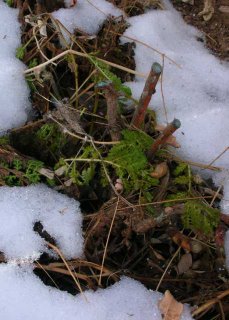 What’s blooming outside: Nothing. The man down the road who painted his new vertical board fence green this past summer added framed pictures of the virgin Mary this week that imitate niches in an adobe wall.
What’s blooming outside: Nothing. The man down the road who painted his new vertical board fence green this past summer added framed pictures of the virgin Mary this week that imitate niches in an adobe wall.What’s blooming inside: Aptenia, zonal geranium..
What’s green and visible in the area: Snow covers everything again.
Animal sightings: Rabbit tracks.
Weather: The early week was cold, but most of the snow was gone by Wednesday. It snowed again Friday night, leaving about half an inch Saturday morning. Temperatures rose above freezing by midmorning, and snow started falling in the afternoon. Another quarter inch accumulated by nightfall when temperatures fell and the snow stopped.
Weekly update: Tansy leaves have survived the snow. It’s the most remarkable thing they’ve done in twelve years.
Tansy promises composite yellow corymbs, leaves that repel insects and rhizomatous roots. Mine never bloomed but it did spread underground. Since I already had any number of combative yellow plants that did flower, I saw no reason to give it leg room. I started pulling it out in 1999, putting some discards in places where nothing grew. It’s taken nine years to rid it from my garden, if I have.
The rejects survived in one place where water is too erratic for anything else. There it behaved almost like a fern bank or low hedge. That is, until the grasshoppers ate it to the ground in 2005. It barely came back this past wet, cool summer.
Tansy has a reputation for such fickleness. An abuela in Taos told Michael Moore the ponso she grew from garden cuttings was safe, but plants that grew from seed were "bad medicine." Tanacetum Vulgare can become so toxic it can kill.
Roman Catholics ritualized its use to young sprouts, limiting it to cakes, teas or puddings eaten during Lent or Holy Week. Many have observed horses and cattle will only eat Tansy leaves when they’re young. Curious Hungarian researchers measured the essential oils during growth and found differences indeed existed in the accumulation patterns of the six chemicals they analyzed.
While variations in chemistry during a plant’s life cycle have long governed human uses of plants, Lithuanian scientists tested Tansy from three locations for several years and found the concentration of volatile oils in mature plants was less in 2002 with a dry, warm spring than in the previous two years. They isolated 41 chemicals in mature plants, and variations in the strength of each within the plants.
Further trying to refine the reasons for the volubility of Tansy, Norwegian chemists brought plants from forty locations to one site where they grew them for two years before extracting the oils. Jens Rohloff’s team found that even then the distilled essential oils varied from 0.35 to 1.90% and those plants that contained the most thujone were especially rich in volatile oils. In addition, they identified six other chemotypes, each of which varied in strength from plant to plant. They had earlier established genetic uniformity in the population.
Canadians discovered the distillation method itself influenced the ability of beta-thujone in Tansy oil to kill spider mites. They also found the presence of another chemical that survived one of the extraction processes may have enhanced the strength of the thujone they took from another species, one of the many chemicals found in unpredictable degrees in Tanacetum Vulgare.
Thujone is most famous for its presence in absinthe. Hold and her colleagues found the terpenoid inhibits the activity of GABA A receptors in the brain which, in turn, prevents the release of chloride to calm neurons. When they gave high doses of thujone to mice, the overexcited neurons produced convulsions, and ultimately death.
The alpha form of thujone is more toxic than the beta. Mockute’s team noted that Tansy from eight countries contained beta-thujone, while plants from three countries had alpha-thujone like that they found in Vilnius.
However, it’s not the thujone that works against Colorado potato beetles, but the vapors which mask the attractive smell of the spuds.
We’re still discovering individual human variations in health and temperament that arise from individual biochemical differences. The possibility that a plant like Tansy that looks so uniform contains the same secret idiosyncracies is beyond our ken. Until science can identify the sources of variability and produce croppable plants, we’ll continue to treat it with prohibitions, do not touch, do not plant, do not nibble.
Notes:
Chiasson H, A.Belanger, N. Bostanian, Cvincent, and A Poliquin. "Acaricidal Properties of Artemisia Absinthium and Tanacetum Vulgare (Asteraceae) Essential Oils Obtained by Three methods of Extraction," Journal of Economic Entomology 94:167-71:2001.
Hold K.M., N. S. Sirisoma, T. Ikeda, T. Narahashi, and J. E. Casida. "Alpha-thujone (the Active Component of Absinthe): Gamma-Aminobutyric Acid type A Receptor Modulation and Metabolic Detoxification," Proceedings, National Academy of Science 97:3826-31:2000.
Moore, Michael in L. S. M. Curtin, Healing Herbs of the Upper Rio Grande, 1947, republished by Western Edge Press of Santa Fe in 1997.
Mockute, Danute and Asta Judzentiene. "Composition of the Essential Oils of Tanacetum Vulgare L. Growing Wild in Vilnius District (Lithuania)," Journal of Essential Oil Research: 16:550-553:2004.
Nèmeth, É. Z., É Héthelyi and J. Bernth, "Comparison Studies on Tanacetum Vulgare L. Chemotypes," Journal of Herbs, Spices & Medicinal Plants 2:85-92:1994.
Rohloff, Jens, Ruth Mordal, and Steinar Dragland. "Chemotypical Variation of Tansy (Tanacetum Vulgare L.) from 40 Different Locations in Norway," Journal of Agricultural and Food Chemistry, 52:1742 -1748:2004.
D. Thiery, D. and J. H. Visser. "Misleading the Colorado Potato Beetle with an Odor Blend ," Journal of Chemical Ecology 13:1139-1146:1987.
Photograph: Tansy with dead rose canes and white stalks of grass and áñil del muerto that did not prosper there, 14 January 2007.
No comments:
Post a Comment